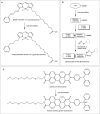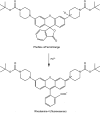International consensus guidelines for the definition, detection, and interpretation of autophagy-dependent ferroptosis
- PMID: 38442890
- PMCID: PMC11210914
- DOI: 10.1080/15548627.2024.2319901
International consensus guidelines for the definition, detection, and interpretation of autophagy-dependent ferroptosis
Abstract
Macroautophagy/autophagy is a complex degradation process with a dual role in cell death that is influenced by the cell types that are involved and the stressors they are exposed to. Ferroptosis is an iron-dependent oxidative form of cell death characterized by unrestricted lipid peroxidation in the context of heterogeneous and plastic mechanisms. Recent studies have shed light on the involvement of specific types of autophagy (e.g. ferritinophagy, lipophagy, and clockophagy) in initiating or executing ferroptotic cell death through the selective degradation of anti-injury proteins or organelles. Conversely, other forms of selective autophagy (e.g. reticulophagy and lysophagy) enhance the cellular defense against ferroptotic damage. Dysregulated autophagy-dependent ferroptosis has implications for a diverse range of pathological conditions. This review aims to present an updated definition of autophagy-dependent ferroptosis, discuss influential substrates and receptors, outline experimental methods, and propose guidelines for interpreting the results.Abbreviation: 3-MA:3-methyladenine; 4HNE: 4-hydroxynonenal; ACD: accidentalcell death; ADF: autophagy-dependentferroptosis; ARE: antioxidant response element; BH2:dihydrobiopterin; BH4: tetrahydrobiopterin; BMDMs: bonemarrow-derived macrophages; CMA: chaperone-mediated autophagy; CQ:chloroquine; DAMPs: danger/damage-associated molecular patterns; EMT,epithelial-mesenchymal transition; EPR: electronparamagnetic resonance; ER, endoplasmic reticulum; FRET: Försterresonance energy transfer; GFP: green fluorescent protein;GSH: glutathione;IF: immunofluorescence; IHC: immunohistochemistry; IOP, intraocularpressure; IRI: ischemia-reperfusion injury; LAA: linoleamide alkyne;MDA: malondialdehyde; PGSK: Phen Green™ SK;RCD: regulatedcell death; PUFAs: polyunsaturated fatty acids; RFP: red fluorescentprotein;ROS: reactive oxygen species; TBA: thiobarbituricacid; TBARS: thiobarbituric acid reactive substances; TEM:transmission electron microscopy.
Keywords: Cell death; ferritinophagy; iron; lipid peroxidation; lipophagy; lysosome.
Conflict of interest statement
L.G. is/has been holding research contracts with Lytix Biopharma, Promontory and Onxeo, has received consulting/advisory honoraria from Boehringer Ingelheim, AstraZeneca, OmniSEQ, Onxeo, The Longevity Labs, Inzen, Imvax, Sotio, Promontory, Noxopharm, EduCom, and the Luke Heller TECPR2 Foundation, and holds Promontory stock options. D.C.R. is a consultant for Aladdin Healthcare Technologies Ltd., Mindrank AI, Nido Biosciences, Drishti Discoveries, Retro Biosciences and PAQ Therapeutics. D.I. G. is an employee and shareholder of AstraZeneca. M. K. serves on the Scientific Advisory Boards of Engine Biosciences, Casma Therapeutics, Cajal Neuroscience, Alector, and Montara Therapeutics, and is an advisor to Modulo Bio and Recursion Therapeutics. X.J. holds inventorship of patents related to autophagy and cell death, and holds equity as well as consults for Exarta Therapeutics and Lime Therapeutics. G.K. has been holding research contracts with Daiichi Sankyo, Eleor, Kaleido, Lytix Pharma, PharmaMar, Osasuna Therapeutics, Samsara Therapeutics, Sanofi, Tollys, and Vascage. G.K. is on the Board of Directors of the Bristol Myers Squibb Foundation France. G.K. is a scientific co-founder of everImmune, Osasuna Therapeutics, Samsara Therapeutics and Therafast Bio. G.K. is in the scientific advisory boards of Hevolution, Institut Servier and Longevity Vision Funds. G.K. is the inventor of patents covering therapeutic targeting of aging, cancer, cystic fibrosis and metabolic disorders. G.K.’wife, Laurence Zitvogel, has held research contracts with Glaxo Smyth Kline, Incyte, Lytix, Kaleido, Innovate Pharma, Daiichi Sankyo, Pilege, Merus, Transgene, 9 m, Tusk and Roche, was on the on the Board of Directors of Transgene, is a cofounder of everImmune, and holds patents covering the treatment of cancer and the therapeutic manipulation of the microbiota. G.K.’s brother, Romano Kroemer, was an employee of Sanofi and now consults for Boehringer-Ingelheim. The other authors declare no conflicts of interest or financial interests. The funders had no role in the writing of the manuscript.
Figures












References
Publication types
MeSH terms
Grants and funding
- R01 CA211070/CA/NCI NIH HHS/United States
- R01 CA160417/CA/NCI NIH HHS/United States
- P30 CA008748/CA/NCI NIH HHS/United States
- R35 GM131689/GM/NIGMS NIH HHS/United States
- R01 CA166413/CA/NCI NIH HHS/United States
- R01 NS089737/NS/NINDS NIH HHS/United States
- R01 CA258622/CA/NCI NIH HHS/United States
- R01 CA204232/CA/NCI NIH HHS/United States
- R01 GM127791/GM/NIGMS NIH HHS/United States
- BBS/E/B/000C0417/BB_/Biotechnology and Biological Sciences Research Council/United Kingdom
- R01 CA229275/CA/NCI NIH HHS/United States
- R35 GM131919/GM/NIGMS NIH HHS/United States
LinkOut - more resources
Full Text Sources
Research Materials
Miscellaneous
